Podcast: Play in new window | Download (Duration: 14:00 — 12.8MB)
Subscribe: Apple Podcasts | RSS
On October 16, 2014 LDS Meridian Magazine published an article by Ted Gibbons titled, “The Fallacy of Rewriting Your Personal History.” Mr. Gibbons relates the story of one of his former missionary companions who, sometime after his mission, was excommunicated from the Church and came to disbelieve Mormonism. This former Mormon subsequently edited his missionary journal to reflect his new understanding of his past Mormon experiences. Mr. Gibbons writes,

“Testimonies and experiences written with power and love in the original copy of his journal were now loaded with qualifiers. Instead of I felt the power of the Holy Spirit, I was reading things like I felt what I thought at the time was the Holy Spirit. Instead of I know the Church is true, this: I thought I knew the Church was true. I do not know if he remembered that I had a copy of the original, but I was saddened by his efforts to make the past coincide with his perceptions at the present time.”
Mr. Gibbons cautions against allowing “the enemy of [your] soul” to provide materials for the rewriting of your spiritual history.
“Not much White Out is required before we begin to doubt the reality of our earlier experiences. When the powerful and confirming feelings come less often, when the early certainties become uncertain memories rather than current realities, then Lucifer moves in with his darkness and his doubts and tries to turn us out of the path we have chosen.”
I can understand Mr. Gibbons’ perspective and concerns, but I think he is failing to see the bigger picture. If someone is born and raised in the Mormon Church, conforming to Mr. Gibbons’ reasoning would result in his hoped-for outcome: Mormons would never leave Mormonism. But.
What about people who converted to Mormonism from a different faith? By Mr. Gibbons’ rationale, if they at one time believed their non-Mormon faith was true, they never should have joined the Mormon Church. He wrote,
“When the inclination comes to wonder if we were misled when we altered our lifestyles and turned into the light—when we begin to suppose that those moments that transformed us were something less than we remember—when we weary under the onslaught of that ‘great fight of afflictions,’ let us remember this reality:
“‘Once there has been illumination beware the temptation to retreat from a good thing. If it was right when you prayed about it and trusted it and lived for it, it is right now. Don’t give up when the pressure mounts. Certainly don’t give in to that being who is bent on the destruction of your happiness. Face your doubts. Master your fears. “Cast not away therefore your confidence” (Hebrews 10:35). Stay the course . . .’ (Elder Jeffrey R. Holland: “Cast Not Away Therefore Your Confidence,” Ensign, March 2000,).”
While I support Mr. Holland’s idea (quoted above) of facing your doubts, the larger argument in Mr. Gibbons’ article seems to be one of desperation. Mormonism is either true or false – it matters not how you or I feel about it. The faith I hold to, the Christian faith, is either true or false. My experiences and how I understand them – now or later – don’t change that a bit.
 New information doesn’t change history; it corrects previously unknown errors. Personal development and gained wisdom don’t change personal history; they often illuminate it.
New information doesn’t change history; it corrects previously unknown errors. Personal development and gained wisdom don’t change personal history; they often illuminate it.
By way of illustration, when I was a child, I waited for Santa Claus with full conviction that he would bring me wonderful gifts on Christmas Eve. As an adult, I understand that I waited for what I thought at the time was Santa Claus, but now know it was my generous and kind parents who lovingly perpetuated a myth to enhance my childhood Christmas experience. (Please note: I am illustrating a point, not drawing a comparison between Mormonism and Santa Claus.) For me to accurately tell this story from my adult perspective does not require a rewriting of history, but rather an acceptance and inclusion of what is actually true.
And isn’t truth what we’re all seeking?
My friends, there is nothing good that comes from doggedly clinging to a myth. While I very much enjoyed my childhood Christmases with what I then believed was a jolly, bearded man called Santa Claus, I’m thankful that I have come to know the truth. I’m thankful that I don’t pin my Christmas joy on a fable that can do naught but disappoint every single year of my adulthood. Indeed, in this regard I can say knowing the truth has set me free to focus on the real reason for Christmas, which brings me far greater joy than the mythical Santa Claus ever did.
So when we wonder if we have been misled, let’s not be discouraged by a warning to refrain from “rewriting history.” Rather than doubting our doubts, let’s face our doubts in a sincere effort to live and write a true and accurate history. For if we seek the truth we will find it (Matthew 7:7). And when we know the truth, the truth will set us free (John 8:32).
As the Mormon Church gears up for the opening of its new temple in Carmel, Indiana, local news sources are letting residents know what to expect once they have a Mormon temple in their region. I’m guessing that the Church put out a new press release because last Wednesday (January 14, 2015) two of these news reports showed up in my inbox. One was from Fox59 News and the other from Current in Carmel.
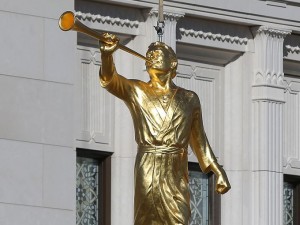 Both news reports included the same basic information, mostly focusing on the benefits a Mormon temple will bring to Indiana. That is, economic growth and population growth for the area; greater understanding of Mormonism among non-Mormons; and “geographic convenience” for local Mormons wishing to attend a temple.
Both news reports included the same basic information, mostly focusing on the benefits a Mormon temple will bring to Indiana. That is, economic growth and population growth for the area; greater understanding of Mormonism among non-Mormons; and “geographic convenience” for local Mormons wishing to attend a temple.
What I found most interesting about these reports is not what they said, but what they didn’t say. Both explained that Mormon temples are used for endowment ceremonies, weddings, and “some” or “certain” baptisms. But neither mentioned the fact that most of the activities done in Mormon temples are done on behalf of the dead.
Readers would have no way of knowing this, but none of the “certain baptisms” mentioned in the news reports are for living people. The living are baptized in Mormon meetinghouses or chapels; the dead are baptized by proxy in Mormon temples.
Endowment ceremonies, weddings and sealings (not specifically mentioned in the news reports) are performed in Mormon temples for both the living and the dead. Temple-worthy Mormons will typically participate in these ceremonies one time for themselves, and then return often to do temple work as proxies for the deceased.
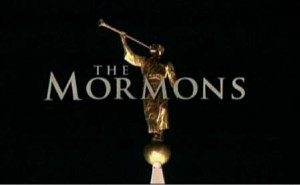 In 2007 PBS aired a two-part documentary titled “The Mormons.” According to the program, at that time two billion names of deceased people had been recorded and were being stored in Mormon vaults outside of Salt Lake City. Of those, Mormons had “baptized well over 100 million deceased people.” According to an article found on the Mormon Newsroom website, 400 million new historic records are being added to that database each year. And the goal of the Mormon Church is to complete the temple work (washings, anointings, baptisms, sealings, endowments and marriages) for each deceased person identified through these records. In fact, the ultimate goal is to do this temple work for every person who has ever lived. Past Mormon prophet Joseph Fielding Smith taught,
In 2007 PBS aired a two-part documentary titled “The Mormons.” According to the program, at that time two billion names of deceased people had been recorded and were being stored in Mormon vaults outside of Salt Lake City. Of those, Mormons had “baptized well over 100 million deceased people.” According to an article found on the Mormon Newsroom website, 400 million new historic records are being added to that database each year. And the goal of the Mormon Church is to complete the temple work (washings, anointings, baptisms, sealings, endowments and marriages) for each deceased person identified through these records. In fact, the ultimate goal is to do this temple work for every person who has ever lived. Past Mormon prophet Joseph Fielding Smith taught,
“…the work must be done in behalf of the dead of the previous 6,000 years, for all who need it. Temples will be built for this purpose, and the labor in them will occupy most of the time of the saints.” (Joseph Fielding Smith, Doctrines of Salvation 2:166)
That’s a lot of temple work for the dead.
So isn’t it interesting that the news reports on the new Indiana temple didn’t even mention that Mormons do work in their temples to benefit the dead?
The fact that proxy work for the dead is done in Mormon temples can be found on the MormonTemples website if one takes the time to look for it. The fact that work on behalf of the dead is the majority of what goes on in Mormon temples is nowhere stated, as far as I can see.
One leg of the three-fold mission of the LDS Church is “redeeming the dead.” A significant purpose for Mormon temples is “redeeming the dead.” The main activity engaged in within those temples is “redeeming the dead.” I find it odd that something so prominent and important — to Mormonism in general and Mormon temples in particular — would be neglected in these news reports. But I suppose it makes for better public relations as the temple open house approaches.
As one of the news reports said, “one of the exciting effects of the new building will be an open house for people outside the faith, which will provide an opportunity for local Mormons to talk about their beliefs in an impressive setting.” Perhaps an impressive setting will be enough of a distraction to keep visitors from thinking too much about *what really goes on inside Mormon temples (link below).
* Not everyone may want to watch this linked video produced by “New Name Noah.” While MRM has no official affiliation with this person, the material was produced by someone who apparently possessed a valid temple recommend and secretly filmed the ordinances inside the temple. This material is readily available on the Internet. Please view at your own discretion.
The following blog article originally posted at Mormon Coffee on January 1, 2008. We repost it today, on the 42nd anniversary of the Roe v. Wade decision. Statistics have been updated.
——————
January 22, marks the 42nd anniversary of the infamous Rose vs. Wade decision making abortion legal in the United States. According to the Guttmacher Institute, nearly 53 million legal abortions have been performed in the U.S. between 1973 and 2011. That averages out to nearly 1.4 million abortions per year. The Mormon Church touts itself as a “pro-life” church although, like many teachings coming out of Salt Lake City, consistency regarding the topic of abortion is lacking.
For example, President Gordon Hinckley, speaking in general conference in October, 1998 noted that abortion was an “ugly thing.” He went on to say,
“While we denounce it, we make allowance in such circumstances as when pregnancy is the result of incest or rape, when the life or health of the mother is judged by competent medical authority to be in serious jeopardy, or when the fetus is known by competent medical authority to have serious defects that will not allow the baby to survive beyond birth.”
 Pro-life ethicists would find Hinckley’s allowances fraught with problems, but it is not my intention at this time to discuss the holes in Hinckley’s statement.
Pro-life ethicists would find Hinckley’s allowances fraught with problems, but it is not my intention at this time to discuss the holes in Hinckley’s statement.
According to the LDS General Handbook of Instructions (11-4), the termination of a pregnancy is “one of the most…sinful practices of this day.” Twelfth President Spencer Kimball said very much the same thing when he wrote,
“Abortion must be considered one of the most revolting and sinful practices in this day…” (The Teachings of Spencer W. Kimball, p.189).
However, the Encyclopedia of Mormonism (1:7), while citing the prohibition to kill found in D&C 59:6, goes on to state,
“With respect to related offenses, the Church distinguishes abortion from murder but holds it an extremely grave action, not to be done except in extremely limited circumstances that might include incest or rape, perils to the life or health of the mother, or severe birth defects. As far as has currently been revealed, a person may repent and be forgiven for the sin of abortion.”
Such statements raise obvious questions. Why does the LDS Church consider abortion a sin, if it is not murder? If abortion in fact “kills” something, what does it kill, and if the object killed was once living and had human DNA, how is this not murder? If that be the case, why is there a provision for forgiveness for this type of murder, yet there is no such provision in Mormonism for any other type of murder?
For further reading see Abortion and LDS Inconsistency
April Young Bennett needed to renew her temple recommend. Her brother was soon to be married in a Mormon temple and she wanted to be there.
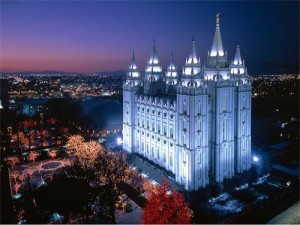 As many of you know, Latter-day Saints who do not hold a current temple recommend are not allowed to enter Mormon temples. They must be “worthy to enter.”
As many of you know, Latter-day Saints who do not hold a current temple recommend are not allowed to enter Mormon temples. They must be “worthy to enter.”
“Once you have some feeling for the value of temple blessings and for the sacredness of the ordinances performed in the temple, you would be hesitant to question the high standards set by the Lord for entrance into the holy temple.
“You must possess a current recommend to be admitted to the temple. This recommend must be signed by the bishop of your ward and the president of your stake…only those who are worthy should go to the temple. The bishop has the responsibility of making inquiries into our personal worthiness. This interview is of great importance to you as a member of the Church, for it is an occasion to explore with an ordained servant of the Lord the pattern of your life. If anything is amiss in your life, the bishop will be able to help you resolve it. Through this procedure, as you counsel with the common judge in Israel, you can declare or can be helped to establish your worthiness to enter the temple with the Lord’s approval.” (LDS Church produced booklet, Preparing to Enter the Holy Temple, 2002)
So Ms. Bennett had the necessary interview with her bishop, who found her worthy to enter the temple.
Ms. Bennett went on to the next step — an interview with her stake president. And this is when the wheels came off the bus.
Ms. Bennett’s stake president, who had “the responsibility of representing the Lord in interviewing” her (ibid.), would not sign her temple recommend.
A recommend interview reportedly consists of 15 questions. Three are questions of faith, and the rest are questions of behavior. Nobody knows Ms. Bennett’s “worthiness” in all of these things, but according to the Salt Lake Tribune, what the stake president deemed a problem was Ms. Bennett’s activity with Ordain Women, a group of Mormons who advocate for inclusion of females in the currently all-male LDS priesthood. The Tribune reported,
“Bennett says her stake president told her that, to keep her recommend, she would have to leave OW’s board…
“Bennett’s LDS stake president, who oversees a several Mormon congregations in the southwest Salt Lake Valley, also insisted that she delete 11 blog posts she had written for Exponent II, she wrote, which has ‘provided a safe forum for Mormon women to share their opinions since 1974.’
“‘Some of the deleted posts literally raised the question of women’s ordination simply by posting an opinion poll question for Exponent readers,’ Bennett wrote, ‘but others, such as “Ordination is the Answer to Correlation,” “Confirming Our Hope: Women and Priesthood,” and “Shouldn’t It Be Obvious? How Women Hold and Exercise the Priesthood Today,” represent months of scripture study and analysis of church history and the teachings of living apostles and auxiliary leaders.’”
Ms. Bennett was given the choice of making herself temple worthy by accepting her stake president’s stipulation, or apparently remaining “unworthy,” thereby missing her brother’s wedding. A hard choice. She wrote,
“I do not believe that temple recommends should be used as leverage to censor ideas or silence advocacy, but if I hadn’t complied, I would have missed my brother’s recent temple wedding. Choosing between following the dictates of my conscience and being present for a family wedding has been heartbreaking. In the end, I concluded that while others may take my place as an author or an advocate, no one can replace me in my role as my brother’s sister.”
Ms. Bennett expressed her hope that Church leadership will one day “respond to the sincere pleas of women with genuine concern, welcoming women’s ideas, requests and suggestions as valuable to the kingdom of God on earth.” She stated that she knows Jesus Christ “does not look upon women who express their desires to participate in his work as nuisances or threats,” yet her stake president, in his ordained capacity of “representing the Lord,” seemed to think otherwise.
Debra Jenson, an Ordain Women board member, described Ms. Bennett’s (and other Mormon’s) “informal discipline” experience this way:
“[I]nformal discipline is a public punishment. It is a scarlet A that she will wear every week. It is a way to brand a member as a threat, to tell the people with whom she worships that she is not their sister. Or worse, it is a warning to others that they must remain quiet and distant or they will suffer her same fate.”
A friend of mine described this whole affair as,
“Emotional blackmail, control, and manipulation used by Mormon leaders to close down discussion and a free exchange of thoughts and ideas.”
What strikes me about Ms. Bennett’s experience is the idea of temple worthiness. This is what a temple recommend interview is about, after all, determining someone’s worthiness to enter into and participate in Mormon temple activities “with the Lord’s approval.” Ms. Bennett was deemed not worthy as a vocal author, advocate, and Ordain Women board member. But as a silent supporter of these same ideals, as a silent supporter of the goals of Ordain Women, her stake president says she is temple worthy. It’s interesting to me that temple worthiness has everything to do with outward behavior and nothing to do with the condition of a person’s heart.
Ms. Bennett’s experience has brought people to thoughts of “public punishment,” “emotional blackmail,” and an “outward behavior” focus of Mormon temple worthiness. What do you think of when you read of Ms. Bennett’s experience?
On Monday (January 12, 2015) I wrote,
The Mormon Church’s Sunday School course of study for 2015 is the New Testament. Accordingly, Gig Harbor, WA newspaper columnist Alfred Gunn (LDS) wrote a column for The Peninsula Gateway titled, “The Bible as a treasured course of personal study.”
For the most part, the article seems aimed at convincing non-Mormons that Mormons love the Bible and hold it in high esteem.
In that blog post I suggested that Mr. Gunn’s readers might be surprised to learn of Mormonism’s less-than-reverent view of the Bible. In this post I want to talk further about an idea suggested by Mr. Gunn; namely,
“To anyone harboring the persistent misconception that ‘Mormons are not Christians because they have their own Bible, the Book of Mormon,’ we say that we believe in the Lord Jesus Christ as our Savior and the author of our salvation and that we believe, revere, study and love the Holy Bible. We do have additional sacred scripture brought forth by the Lord, including the Book of Mormon, which supports the Bible, never substituting for it.”
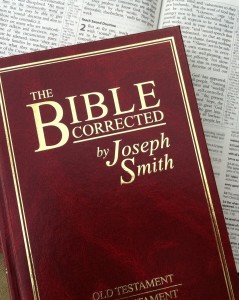 In addition to being surprised by the classic LDS view of the overall insufficiency and fallibility of the Bible, another surprise awaits Mr. Gunn’s readers. That is, while Mormons will be studying the New Testament in 2015, their lessons will often employ Joseph Smith’s own “translation” of the Bible. Mormon apostle Bruce McConkie told Mormon Church members of the value of this altered and “corrected” Bible:
In addition to being surprised by the classic LDS view of the overall insufficiency and fallibility of the Bible, another surprise awaits Mr. Gunn’s readers. That is, while Mormons will be studying the New Testament in 2015, their lessons will often employ Joseph Smith’s own “translation” of the Bible. Mormon apostle Bruce McConkie told Mormon Church members of the value of this altered and “corrected” Bible:
“The Joseph Smith Translation, or Inspired Version, is a thousand times over the best Bible now existing on earth. It contains all that the King James Version does, plus pages of additions and corrections and an occasional deletion. It was made by the spirit of revelation, and the changes and additions are the equivalent of the revealed word in the Book of Mormon and the Doctrine and Covenants. For historical and other reasons, there has been among some members of the Church in times past some prejudice and misunderstanding of the place of the Joseph Smith Translation. I hope this has now all vanished away. Our new Church Bible footnotes many of the major changes made in the Inspired Version and has a seventeen-page section which sets forth excerpts that are too lengthy for inclusion in the footnotes. Reference to this section and to the footnotes themselves will give anyone who has spiritual insight a deep appreciation of this revelatory work of the Prophet Joseph Smith. It is one of the great evidences of his prophetic call” (Sermons and Writings of Bruce R. McConkie, 289).
Looking at the first lesson in the Gospel Doctrine: New Testament Teacher’s Manual used for the 2015 Mormon Sunday School course of study, class members are directed to passages from Luke and John, both specifically from the Joseph Smith Translation (JST).
In the passage from Luke (JST 3:4-11; KJV 3:4-6) Joseph Smith added over 190 words to the biblical text that, in the King James Version, comprises only 74 total words.
In the passage from John (JST 1:1-14; KJV follows the same verses) Joseph Smith altered the KJV text to teach doctrine very different from historic biblical teachings. Consider two verses from this passage. The King James Version says,
“In the beginning was the Word, and the Word was with God, and the Word was God…In him was life; and the life was the light of men.” (John 1:1, 4)
The Joseph Smith Translation says,
“In the beginning was the gospel preached through the Son. And the gospel was the word, and the word was with the Son, and the Son was with God, and the Son was of God…In him was the gospel, and the gospel was the life, and the life was the light of men;” (JST John 1:1, 4).
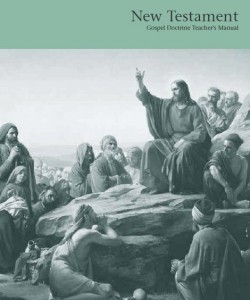 Though the identity of Jesus as the Word is obscured in the verse from the JST, and though Joseph Smith’s assertion in the text itself is that “the gospel was the word,” the LDS Teacher’s Manual explains, “‘the Word’ in John 1:1…refers to the Savior.”
Though the identity of Jesus as the Word is obscured in the verse from the JST, and though Joseph Smith’s assertion in the text itself is that “the gospel was the word,” the LDS Teacher’s Manual explains, “‘the Word’ in John 1:1…refers to the Savior.”
[As an aside, how does that make sense? The JST verse would then be rendered, “In the beginning was the gospel preached through the Son. And the gospel was the Savior, and the Savior was with the Son, and the Son was with God, and the Son was of God.”]
Let’s parse this passage a bit. As I understand it, in the Bible the focus of John 1:1 is the identity and eternality of Christ, the second member of the Trinity.
In Joseph Smith’s “translation” the focus is on the continuity across time of the preaching of the gospel and the gospel’s presence with the Son.
In the Bible, Christ, as the Word, is identified as God.
In the JST, Christ is not said to be God, but said to be “of God.”
In the Bible we are told that in Jesus is life (i.e., He has life within Himself, He is the source of life, another proclamation of His deity; see John 5:26), and that this life is the light of men (Christ is the Provider of both natural and eternal life).
In the JST the gospel (i.e., “all the doctrines, principles, laws, ordinances, and covenants necessary for us to be exalted in the celestial kingdom”) was “in him,” and this system (not Christ Himself) is the life and light of men.
The LDS Teacher’s Manual explains the Mormon understanding of Christ based on John1:1-3, 14:
“a. He ‘was in the beginning’ with God the Father (John 1:1–2). Note that the Savior’s mission began in the premortal world, long before he was born in Bethlehem.
“b. He is God (John 1:1). Explain that when we speak of God, we usually refer to Heavenly Father. However, ‘the personage known as Jehovah in Old Testament times … is the Son, known as Jesus Christ, … who is also a God. Jesus works under the direction of the Father. … Many of the things that the scripture says were done by God were actually done by … Jesus’ (Bible Dictionary, ‘God,’ 681).
“c. Through him the gospel was preached in the premortal world (Joseph Smith Translation, John 1:1).
“d. He made all things (John 1:3).
“e. He is the Only Begotten Son of God in the flesh (John 1:14; see also 1 Nephi 11:14–21).”
As is evident, some superficial similarities exist between the biblical Jesus and Mormonism’s Jesus, but the disparities are vast and very deep. So much so that Christians generally agree with late Mormon Church President Gordon B. Hinckley who said that Mormons believe in a “different Jesus.”
Mr. Gunn promoted the idea that Mormonism is a Christian religion because Mormons believe in Jesus Christ as Savior and because they study the Bible. Superficially, that argument may have some merit. But looking beneath the surface reveals something else altogether. Mormonism promotes trust in a “different Jesus” who cannot save, and teaches doctrine from a false prophet’s rewrite of the Holy Bible. For those who believe the Bible as God gave and preserved it through millennia, this places Mormonism far outside the boundaries of Christianity.
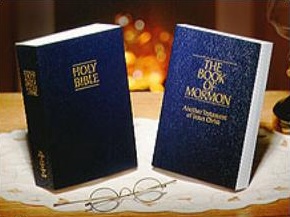 The Mormon Church’s Sunday School course of study for 2015 is the New Testament. Accordingly, Gig Harbor, WA newspaper columnist Alfred Gunn (LDS) wrote a column for The Peninsula Gateway titled, “The Bible as a treasured course of personal study.”
The Mormon Church’s Sunday School course of study for 2015 is the New Testament. Accordingly, Gig Harbor, WA newspaper columnist Alfred Gunn (LDS) wrote a column for The Peninsula Gateway titled, “The Bible as a treasured course of personal study.”
A central point of the article seems to be that of convincing non-Mormons that Mormons love the Bible and hold it in high esteem. Mr. Gunn wrote:
“To anyone harboring the persistent misconception that ‘Mormons are not Christians because they have their own Bible, the Book of Mormon,’ we say that we believe in the Lord Jesus Christ as our Savior and the author of our salvation and that we believe, revere, study and love the Holy Bible. We do have additional sacred scripture brought forth by the Lord, including the Book of Mormon, which supports the Bible, never substituting for it.”
Those reading Mr. Gunn’s column, therefore, would be surprised to learn what Mormon leaders have taught about the Bible. For example, regarding the content of the Bible, Joseph Smith explained,
“There are many things in the Bible which do not, as they now stand, accord with the revelations of the Holy Ghost to me.” (Teachings of the Prophet Joseph Smith, 310. See also History of the Church 5:425)
Regarding the fidelity of the Bible, Mormon apostle Mark E. Petersen said,
“Many insertions were made, some of them ‘slanted’ for selfish purposes, while at times deliberate falsifications and fabrications were perpetrated.” (As Translated Correctly, 4)
Regarding the accuracy of the Bible, the LDS First Presidency wrote:
“Many versions of the Bible are available today. Unfortunately, no original manuscripts of any portion of the Bible are available for comparison to determine the most accurate version. However, the Lord has revealed clearly the doctrines of the gospel in these latter days. The most reliable way to measure the accuracy of any biblical passage is not by comparing different texts, but by comparison with the Book of Mormon and modern-day revelations.” (Presidents Ezra Taft Benson, Gordon B. Hinckley, and Thomas Monson, “Letter Reaffirms use of King James Version Bible,” Church News, June 20, 1992, 3)
Regarding the value of the Bible within the Mormon faith, the Church’s 13th President wrote,
“All scripture is not of equal value. The book that is the ‘keystone of our religion’ [i.e., the Book of Mormon] and that will get a man ‘nearer to God by abiding by its precepts, than by any other book’ needs to be studied constantly.” (Ezra Taft Benson, A Witness and a Warning, vii)
 Regarding the value of the Bible as pertains to eternal life, LDS apostle Bruce McConkie wrote,
Regarding the value of the Bible as pertains to eternal life, LDS apostle Bruce McConkie wrote,
“It is the Book of Mormon, not the Bible, that prepares men, in the full and true sense, for the Second Coming of the Son of Man. And when the eternal ledgers are finally balanced, more souls will have been saved in the celestial kingdom — ten thousand times over — because of the Book of Mormon than have so obtained because of the Bible. It is the Book of Mormon that proves the restoration of the gospel; that converts penitent souls to its saving doctrines; that gathers Israel from all the nations of the earth; that guides and inspires those sainted souls who are preparing themselves to abide the day of the coming of the Lord; and that will continue to guide and inspire gathered Israel in the great Millennial day that lies ahead.” (Bruce R. McConkie, A New Witness for the Articles of Faith, 394).
Regarding the need for the Bible, LDS apostle Bruce McConkie taught,
“By way of perspective, as far as gaining salvation is concerned, the Bible is far excelled—immeasurably so—by the Book of Mormon and the other latter-day revelations. These modern scriptures are in fact the ones that must be believed and accepted in order for us to be saved. If it came right down to it, those of us who live in the dispensation of the fulness of times could be saved if there were no Bible at all, because the gospel truths and powers have all been given anew to us by direct revelation.” (Bruce R. McConkie, “The Bible: A Sealed Book,” a BYU speech given to LDS Seminary and Institute teachers, August 1984)
This small sampling of Mormon teachings on the insufficiency, fallibility, and inferiority of the Bible is just the tip of a very large iceberg. When Mr. Gunn wrote that Mormons “believe, revere, study and love the Holy Bible,” he must have had some private qualifiers in mind that he neglected to share with his readers. For Mormonism is built on the foundation of a corrupted Bible (I Nephi 13:26) and a corrupt Christianity (JS-History 1:19) — both requiring Joseph Smith to correct and restore them.
For Mormons, the Bible can only be correctly understood in light of “the doctrines of the gospel” revealed in “these latter days.” I’ll take a look at this in my next blog post coming up on Thursday (January 15, 2015).
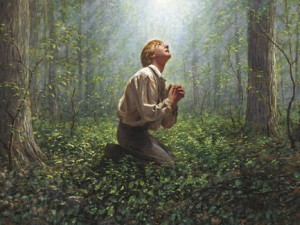 In the spring of 1820 Joseph Smith went into the woods to pray. “Humbly kneeling, sweet appealing–‘Twas the boy’s first uttered prayer” says the Mormon hymn (“Joseph Smith’s First Prayer”).
In the spring of 1820 Joseph Smith went into the woods to pray. “Humbly kneeling, sweet appealing–‘Twas the boy’s first uttered prayer” says the Mormon hymn (“Joseph Smith’s First Prayer”).
Joseph sought to know “Who of all these parties [Presbyterians, Baptists and Methodists] are right; or are they all wrong together? If any one of them be right, which is it…?” In answer to his prayer, two Divine beings appeared before him.
“Then, to his infinite astonishment, he was told that he, Joseph Smith—young, unlearned, but humble—was to be the instrument through whom the Almighty would reestablish His work in these, the latter day…Such was the glorious beginning of the Restoration of the Church of Jesus Christ.” (“Joseph Smith the Prophet,” David B. Haight, Liahona, June 2002)
According to the official version of the First Vision, Joseph Smith was but 14 years old when this happened.
 During General Conference in April 1971, noting Joseph Smith’s youthfulness, then-apostle Ezra Taft Benson described him as a “boy prophet.” Indeed, the age of Joseph Smith at the time of his First Vision is typically included as an important part of the story.
During General Conference in April 1971, noting Joseph Smith’s youthfulness, then-apostle Ezra Taft Benson described him as a “boy prophet.” Indeed, the age of Joseph Smith at the time of his First Vision is typically included as an important part of the story.
For example, the Mormon Church’s Doctrine and Covenants and Church History: Gospel Doctrine Teacher’s Manual instructs, “Teachers of youth may want to emphasize that Joseph Smith was only 14 years old when he received the First Vision” (“I Had Seen a Vision,” 11-15).
The most recent General Conference found Joseph Smith described as a “boy” or a “young boy” at the time of his First Vision, by three different speakers (see Ensign, 11/14, 51, 70, 105).
 In his own telling of the First Vision story, Joseph Smith referred to himself as “an obscure boy” and “a boy of no consequence” (see Joseph Smith – History 1:22-23).
In his own telling of the First Vision story, Joseph Smith referred to himself as “an obscure boy” and “a boy of no consequence” (see Joseph Smith – History 1:22-23).
I think everyone would agree that, at 14 years of age, Joseph Smith was a boy–even a young boy—at the time of this foundational event of the Mormon Restoration.
Yet, even though 14-year-old Joseph Smith is established and accepted as a “boy prophet,” a “young boy,” and a “boy of no consequence,” Mormons choose to describe 14-year-old Helen Mar Kimball as a “woman” or a “young woman” when Joseph Smith was sealed to her as his 25th plural wife.
The LDS Gospel Topics essay, “Plural Marriage in Kirtland and Nauvoo,” refers to all of Joseph Smith’s wives as “women.” It notes that during that time in American history, some “women” married in their “mid-teens.” Though Joseph Smith married two girls at 14 or 15 years of age (Helen Mar Kimball and Nancy Maria Winchester) the essay never uses the words “girls” or “young girls.” But this is what they were.
At the time Joseph Smith married Helen Mar Kimball, she was the same age (within a few months) as Joseph Smith was when he became the “boy prophet.” If Joseph Smith was a “young boy,” Helen Mar Kimball was certainly a “young girl.” It really cannot be had both ways — Joseph a boy and Helen a woman. Either Joseph was a man at the time of his First Vision, or Helen and Nancy were but girls when the 37-year-old prophet added them to his society of plural wives.
 Though it is understandably more comfortable to imagine Helen Mar Kimball as a “woman” when Joseph Smith married her, Latter-day Saints would get a more accurate picture by keeping in mind Mormon-produced First Vision artwork of the boy prophet. There they may find a candid portrayal of some of Joseph Smith’s wives reflected in his youthful face.
Though it is understandably more comfortable to imagine Helen Mar Kimball as a “woman” when Joseph Smith married her, Latter-day Saints would get a more accurate picture by keeping in mind Mormon-produced First Vision artwork of the boy prophet. There they may find a candid portrayal of some of Joseph Smith’s wives reflected in his youthful face.
*The blog title is a quote from a Church-produced video shown at the Carthage Jail Visitors Center, also found here.
In the “Explanatory Introduction” to the Doctrine and Covenants, the book is described as
“a collection of divine revelations and inspired declarations given for the establishment and regulation of the kingdom of God on the earth in the last days. Although most of the sections are directed to members of The Church of Jesus Christ of Latter-day Saints, the messages, warnings, and exhortations are for the benefit of all mankind, and contain an invitation to all people everywhere to hear the voice of Jesus Christ, speaking to them for their temporal well-being and their everlasting salvation.”
The introduction goes on to say that the Doctrine and Covenants, or D&C,
“is unique because it is not a translation of an ancient document, but is of modern origin and was given of God through his chosen prophets for the restoration of his holy work and the establishment of the kingdom of God on earth in these days.”
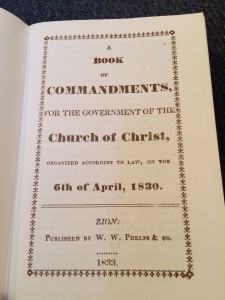 The pre-curser to the D&C is the Book of Commandments. This compilation of alleged revelations to Joseph Smith contained sixty-five chapters and was published in 1833. According to an essay on lds.org,
The pre-curser to the D&C is the Book of Commandments. This compilation of alleged revelations to Joseph Smith contained sixty-five chapters and was published in 1833. According to an essay on lds.org,
“To again correct errors, clarify wording, and recognize developments in Church doctrine and organization, Joseph Smith oversaw the editing of the text of some revelations to prepare them for publication in 1835 as the Doctrine and Covenants of the Church of the Latter Day Saints.”
This new edition included 103 sections.
The 1835 D&C was originally broken down into two sections. The preface states that
“the first part of the book will be found to contain a series of Lectures as delivered before a Theological class in this place, and in consequences of their embracing the important doctrine of salvation, we have arranged them into the following work.”
It goes on to say that
“the second part contains items or principles for the regulation of the church, as taken from the revelations which have been given since its organization, as well as from former ones.”
The introduction to current editions of the D&C notes,
“Beginning with the 1835 edition a series of seven theological lessons was also included; these were titled the Lectures on Faith. These had been prepared for use in the School of the Prophets in Kirtland, Ohio, in 1834-1835. Although profitable for doctrine and instruction, these lectures have been omitted from the Doctrine and Covenants since the 1921 edition because they were not given or presented as revelations to the whole Church.”
This explanation to “decanonize” a portion of scripture doesn’t seem to agree with the description given in History of the Church 2:243ff. Page 243 states that on September 24, 1834, a committee was formed “for the purpose of arranging the items of the doctrine of Jesus Christ for the government of the Church.” The committee included Joseph Smith, Sidney Rigdon, Oliver Cowdery, and Frederick G. Williams. When they finished the “book according to the instructions given them,” a “general assembly of the Church of Latter-day Saints was held at Kirtland” on August 17, 1835.
During this meeting, Oliver Cowdery “arose and introduced the ‘Book of Doctrine and Covenants of the Church of the Latter-day Saints,’ in behalf of the committee. He was followed by President Rigdon, who explained the manner by which they intended to obtain the voice of the assembly for or against said book.” According to this account, W. W. Phelps “bore record that the book presented to the assembly was true.” Afterwards, President John Whitmer, also “testified that it was true. It also reports that “Elder John Smith, taking the lead of the High Council in Kirtland, bore record that the revelations in said book were true, and that the lectures were judiciously arranged and compiled, and were profitable for doctrine.”
As a result, “the High Council of Kirtland accepted and acknowledged them as the doctrine and covenants of their faith by a unanimous vote.”
History of the Church 2:245-46 also includes the “Testimony of the Twelve Apostles to the Truth of the Book of Doctrine and Covenants” as well as testimony from several other leaders in the church who “bore record of the truth of the book.” The fact that they bore witness to the book’s truthfulness is important since one of the arguments used to justify decanonizing the Lectures is that they were not “revelations.” These testimonies tend to prove that there was no distinction when it came to their approval.
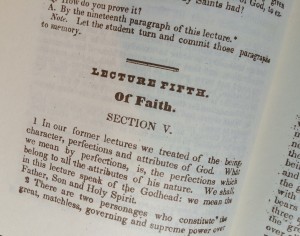 Larry E. Dahl, professor emeritus of Church history and doctrine at Brigham Young University, wrote an essay titled “Authorship and History of the Lectures on Faith.” It gives reasons to believe that the explanation in the current editions of the D&C is not complete.
Larry E. Dahl, professor emeritus of Church history and doctrine at Brigham Young University, wrote an essay titled “Authorship and History of the Lectures on Faith.” It gives reasons to believe that the explanation in the current editions of the D&C is not complete.
“Church leaders have acknowledged that the decision to omit the Lectures on Faith in the 1921 edition of the Doctrine and Covenants was based not only on the fact that they are not revelations, but it also had to do with some of the teachings about the Godhead in Lecture 5.”
Lecture 5, or Lecture Fifth as it is now known, is certainly controversial for it states:
“There are two personages who constitute the great, matchless, governing and supreme power over all things… They are the Father and the Son: The Father being a personage of spirit, glory and power: possessing all perfection and fulness: The Son, who was in the bosom of the Father, a personage of tabernacle, made or fashioned like unto man.”
Speaking of Jesus, Lecture Fifth goes on to say,
“And he being the only begotten of the Father, full of grace and truth, and having overcome, received a fulness of the glory of the Father — possessing the same mind with the Father, which is the Holy Spirit.”
In the Question and Answer section of Lecture Fifth, it asks,
“How many personages are there in the Godhead? Two: the Father and the Son.”
Later comes this question,
“Do the Father and Son possess the same mind? They do. What is this mind? The Holy Spirit.”
Near the end of the Q&A section it asks,
“Does the foregoing account of the Godhead lay a sure foundation for the exercise of faith in him unto life and salvation? It does.”
It is easy to see why this would cause concern for the leaders of the LDS Church. Joseph Smith’s understanding of God had evolved quite considerably over the nine years since the D&C was first published. By the time he died in June 1844, Smith had moved far away from the modalistic dogma of the Book of Mormon. He had abandoned belief in a godhead of two personages while trading a God of spirit for a God of flesh and bones. Mormons today are led to believe that God is only one in purpose and that the Father, Son, and Holy Ghost (Spirit) are three separate deities.
Mormons are taught that their living prophets cannot lead the membership astray. Would this not demonstrate that such a tenet is questionable? What would happen today to a member who insisted vocally that only two personages were in the Godhead and that God was a God of spirit?
“My heart was already full as John Piper began his message that would close the recent Together for the Gospel conference. I prayed that God would use his message to implant a passion within our hearts that would shape our lives and ministries for the length of our days.”
So wrote Christian theologian Al Mohler as he reflected on a gospel message preached by John Piper. As you watch this video of Dr. Piper “pleading with sinners, pointing to Christ, unashamed to plead with emotion and passion and agonized urgency,” I pray you will embrace the Holy Spirit as He softly and tenderly calls you to “come home.”
Sinner, Come Home from Desiring God on Vimeo.